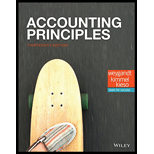
(a)
Journalizing: It is the process of recording the transactions of an organization in a chronological order. Based on these
Accounting rules for journal entries:
- To increase balance of the account: Debit assets, expenses, losses and credit all liabilities, capital, revenue and gains.
- To decrease balance of the account: Credit assets, expenses, losses and debit all liabilities, capital, revenue and gains.
Léger Account: Leger account is an accountings book in which the debit entries are shown at the left side of the account and credit entries are shown at the right side of the account. It can be termed as principal book.
To prepare:
(b)
To prepare: A trial balance.
(c)
To identify: The net income without the preparation of income statement.
Want to see the full answer?
Check out a sample textbook solution
Chapter 3 Solutions
EBK ACCOUNTING PRINCIPLES
- Can you solve this financial accounting problem using appropriate financial principles?arrow_forwardPlease show me the valid approach to solving this financial accounting problem with correct methods.arrow_forwardI need help solving this financial accounting question with the proper methodology.arrow_forward
- I need assistance with this financial accounting problem using valid financial procedures.arrow_forwardI am looking for the correct answer to this financial accounting question with appropriate explanations.arrow_forwardCan you solve this general accounting problem using appropriate accounting principles?arrow_forward

 AccountingAccountingISBN:9781337272094Author:WARREN, Carl S., Reeve, James M., Duchac, Jonathan E.Publisher:Cengage Learning,
AccountingAccountingISBN:9781337272094Author:WARREN, Carl S., Reeve, James M., Duchac, Jonathan E.Publisher:Cengage Learning, Accounting Information SystemsAccountingISBN:9781337619202Author:Hall, James A.Publisher:Cengage Learning,
Accounting Information SystemsAccountingISBN:9781337619202Author:Hall, James A.Publisher:Cengage Learning, Horngren's Cost Accounting: A Managerial Emphasis...AccountingISBN:9780134475585Author:Srikant M. Datar, Madhav V. RajanPublisher:PEARSON
Horngren's Cost Accounting: A Managerial Emphasis...AccountingISBN:9780134475585Author:Srikant M. Datar, Madhav V. RajanPublisher:PEARSON Intermediate AccountingAccountingISBN:9781259722660Author:J. David Spiceland, Mark W. Nelson, Wayne M ThomasPublisher:McGraw-Hill Education
Intermediate AccountingAccountingISBN:9781259722660Author:J. David Spiceland, Mark W. Nelson, Wayne M ThomasPublisher:McGraw-Hill Education Financial and Managerial AccountingAccountingISBN:9781259726705Author:John J Wild, Ken W. Shaw, Barbara Chiappetta Fundamental Accounting PrinciplesPublisher:McGraw-Hill Education
Financial and Managerial AccountingAccountingISBN:9781259726705Author:John J Wild, Ken W. Shaw, Barbara Chiappetta Fundamental Accounting PrinciplesPublisher:McGraw-Hill Education





